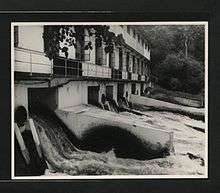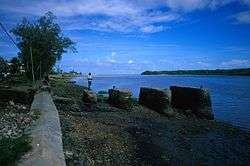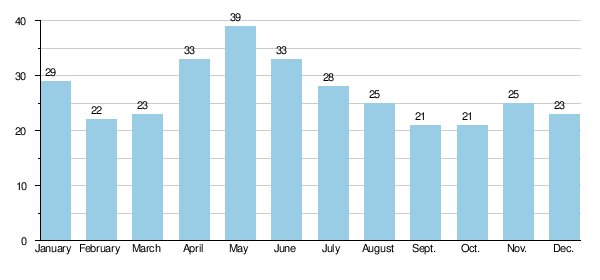Pangani River
| Pangani River | |
|---|---|
|
Pangani Town on Pangani River | |
 | |
| Country | Tanzania |
| Basin | |
| Main source | Nyumba ya Mungu Reservoir |
| River mouth | Indian Ocean at the town of Pangani |
| Basin size | 43,650 km2 (16,850 sq mi)[1] |
| Physical characteristics | |
| Discharge |
|
| Features | |
| Tributaries |
|

The Pangani River (pin-gi'nee) (also called Luffu and Jipe Ruvu, especially in older sources, and probably once called Rhaptus) is a major river of northeastern Tanzania. It has two main sources:[2] the Ruvu, which rises as Lumi at Kilimanjaro, passes through Lake Jipe, and empties into the Nyumba ya Mungu Reservoir, and the Kikuletwa, coming from the west and mainly fed by Mount Meru, which also enters into the Nyumba ya Mungu Reservoir. Just after leaving the reservoir the stream becomes the Pangani, which empties into the Indian Ocean at the town of Pangani.[3]
For much of its length the river flows along the regional borders of Kilimanjaro Region and Manyara Region, before flowing into Tanga Region, which contains the 68 MW Pangani Power Station and the Pangani Falls Dam. There are several inhabited islands within the river. The river is full of crocodiles; hippopotami are scarcer in its lower parts.
Etymology
A main source of Pangani originates on Kilimanjaro, where it is the River Lumi. Lake Jipe may be considered a backwater of the Lumi.[4]
Below Lake Jipe and above the falls, the river is referred to as "Ruvu".[5]
Formerly the main course towards the sea was alternatively called "Ruvu" and "Pangani".[6] Nowadays that has been settled as "Pangani" from the Nyumba ya Mungu reservoir to the Ocean.
While the Sudheli language calls it "Pangani" (meaning distribute or arrange),[7] it is called "Luffu" by the Wasambara (indigenous to the Nderema area, on the three ridges nearer the coast) and Wasegua (who live on the river's islands).[3][5]
Almost all authorities agree that the river "Rhaptus" of Ptolemy's topographical maps is the Pangani of modern maps.[8]
Geography
The Pangani is 500 kilometres (310 mi) in length.[9]
- Source
One source of the river rises in Kilimanjaro, about 120 miles (190 km) from the sea. Known as the Lumi in this area, its course runs through Lake Jipe. The other is at Mount Meru in the west and is known as the Kikuletwa. Like all African rivers, its depth varies with the season. The river is highest around May and lowest around October.

- Midsection
It is navigable for small craft between the lake and the Höhnel Cataracts, a series of rapids.[10] Below the Höhnel Cataracts, it has numerous tributaries, and many islands with villages on them. The stream is strongest above Koleni, within 5 miles of the Pangani Falls, where the river is narrow. This section is not navigable for any considerable distance on account of the falls, which are about 30 miles (48 km) from the mouth. Approximately 4 miles (6.4 km) from the mouth, dense mangrove swamp covers the flatland between the hills on either side. In this area, near Teufelsfelsen, are higher land, a fertile area, and the arid Masai Steppe.[9] On this bank is Mount Kovu Kovu, 360 feet (110 m) in height, while on the south bank is a ridge 400 feet (120 m) high. Pombwe, one of the principal settlements on the river, is situated about 1 mile (1.6 km) west of Kovu Kovu. Above Pombwe, the West African oil palm grows, while below Pombwe, the trees are chiefly areca and coconut palms.[11] The village of Lemkuna and the hamlet of Ngage are on the river's west bank, while Mvungwe and Meserani are on its eastern bank.[12]

- Mouth
The mouth is located 52 kilometres (32 mi) south of Tanga.[7] The river is tidal for a distance of 22 miles (35 km) from the entrance.[11] The southern side of the entrance is marked by a perpendicular bluff named Bweni, about 200 feet (61 m) high; there is a village of the same name, Bweni, situated here. The northern side of the entrance is a flat sandy beach that extends from the head of the bay. There are several settlements at the entrance, two on the northern and two on the southern bank. Historically, the town of Pangani, on the river's left bank, had a reputation for fevers.[13] At its estuary, by Pangani town, the river is about 600 feet (180 m) in breadth, and 12–15 feet (3.7–4.6 m) deep.
- Tributaries
Several tributaries coming from the Pare Mountains, the Usambara Mountains and the Wasegiia wilderness join the Pangani in its course. These include the Kibaya, Komkuza, Kwachigulu, Kwamwadyau and Mnyusi.[14]
Hydrometry
Average monthly flow of Pangani measured at the hydrological station in Korogwe Estate, about 110 km above the mouth in m³ / s (1959–77).[15] The Pangani flows stimulate time-dependent, like most rivers in the region.

Pangani River Basin
The Pangani River Basin (PRB) makes up one of Tanzania's nine drainage basins. Covering an area from the northern highlands down to the northeastern coastline, the PRB is approximately 56,300 square kilometres (21,700 sq mi) in size, of which 4,880 square kilometres (1,880 sq mi) lie within Kenya.[16] Five sub-basins make up the basin, namely the Pangani River (43,650 km2 or 16,850 sq mi), Umba River (8,070 km2 or 3,120 sq mi), Msangazi River (5,030 km2 or 1,940 sq mi), Zigi River and Mkulumuzi River (2,080 km2 or 800 sq mi), which all empty into the Indian Ocean.[17]
The Pangani Basin Water Board (PBWB) was established in July 1991 in accordance with the Water Utilization (Control and Regulation) Act No. 42 of 1974, with its headquarters in the municipality of Moshi in Kilimanjaro Region, and two other offices in Arusha and Tanga.[17] The PBWB consists of ten professionals from public institutions and private sector LGAs, UWSAs and other committees.
The river system is under pressure from conflicts of interest in water use. Many farmers rely on the river for irrigation and damming projects along the river have reduced several hundreds to less than 40 cubic metres per second (1,400 cu ft/s), affecting coastal communities, which have seen fish populations dramatically reduced.[18] In 2002, the Pangani River Basin Management Project (PRBMP) was established to manage the basin's water resources. It receives technical assistance from the International Union for Conservation of Nature (IUCN), the Netherlands Development Organization (SNV) and the local NGO PAMOJA.[18] The project also receives funds from the Government of Tanzania, IUCN, the European Commission (EU) and the Global Environment Facility through the UNDP.[18]
Commerce
There is a good deal of trade here, dhows loading and unloading on the river. Produce is brought down the river, principally on rafts made of the Moale palm, which are then broken up and become articles of commerce. In 1878, the most common crop cultivated on the river's banks was reported to be sugar.[13]
References
- ↑ Pangani basin: a situation analysis. Retrieved 10 December 2011.
- ↑ Entry "Pangani" in the German Koloniallexikon
- 1 2 THE CHRISTIAN MISSIONARY INTELLIGENCER (Now in the public domain. ed.). 1852. pp. 93–. Retrieved 8 October 2011.
- ↑ Meyer, Hans (1891). Across East African glaciers: an account of the first ascent of Kilimanjaro (Now in the public domain. ed.). G. Philip & son. pp. 321–. Retrieved 11 October 2011.
- 1 2 Royal Geographical Society (Great Britain); Shaw, Norton; Galton, Sir Francis; Sir Clements Robert Markham, William Spottiswoode, Henry Walter Bates, Sir John Scott Keltie (1875). Proceedings ... (Now in the public domain. ed.). pp. 318–. Retrieved 9 October 2011. Cite uses deprecated parameter
|coauthors=(help) - ↑ cf the map Sheet SB 37/2, Series Y401, by War Office 1946 of 1946 and this map from 1960 Sheet SB-37-2 Series Y503, Edition 1-TSD, Published by the Survey Division, Ministry of Lands, Survey and Water, Tanganyika 1960, both showing "Pangani or Ruvu River" as name
- 1 2 Hodd, Michael (22 March 2002). East Africa handbook. pp. 383–. ISBN 978-1-900949-65-1. Retrieved 11 October 2011.
- ↑ Royal Geographical Society (Great Britain) (1891). Proceedings of the Royal Geographical Society and monthly record of geography (Now in the public domain. ed.). Edward Stanford. pp. 524–. Retrieved 8 October 2011.
- 1 2 "Pangani Basin". IWMNet. Retrieved 12 October 2011.
- ↑ Lewin, Evans (1924). Africa (Now in the public domain. ed.). Clarendon press. p. 108. Retrieved 11 October 2011.
- 1 2 United States. Hydrographic Office (1916). Africa Pilot: South and east coasts of Africa from Cape of Good Hope to Ras Hafun (Now in the public domain. ed.). Hydrographic office under the authority of the secretary of the navy. pp. 392–. Retrieved 8 October 2011.
- ↑ Catchment ecosystems and downstream water : the value of water resources in the Pangani basin, Tanzania. IUCN. pp. 34–. ISBN 978-955-8177-49-5. Retrieved 11 October 2011.
- 1 2 Great Britain. Hydrographic Office (1878). Africa pilot: South and east coasts of Africa, from the Cape of Good Hope to Cape Guardafui, including the islands in Mozambique Channel (Now in the public domain ed.). Printed for the Hydrographic Office, Admiralty. pp. 327, 328–. Retrieved 8 October 2011.
- ↑ Journal of tropical medicine and hygiene. Staples and Staples, Ltd. 1959. p. 40. Retrieved 8 October 2011.
- ↑ GRDC - The Pangani in Korogwe
- ↑ Bhatt, Yogesh Chandra; Bossio, Deborah; Enfors, E.; Gordon, L.; Kongo, V.; Kosgei, J. R.; Makurira, H.; Masuki, K.; Mul, M.; Tumbo, S. D. (2006). Smallholder system innovations in integrated watershed management (SSI): Strategies of water for food and environmental security in drought-prone tropical and subtropical agro-ecosystems. IWMI. pp. 10–. ISBN 978-92-9090-634-6. Retrieved 8 October 2011.
- 1 2 "Pangani Basin". Pangani Basin Water Board. Retrieved 9 October 2011.
- 1 2 3 "Pangani River Basin". International Union for Conservation of Nature. Retrieved 9 October 2011.
External links
| Wikimedia Commons has media related to Pangani River. |
Coordinates: 5°26′S 38°58′E / 5.433°S 38.967°E
